Understanding the Cost Factors of Diamond Rings
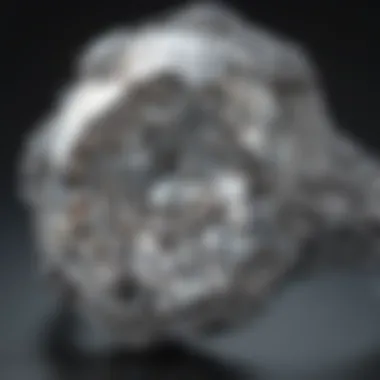
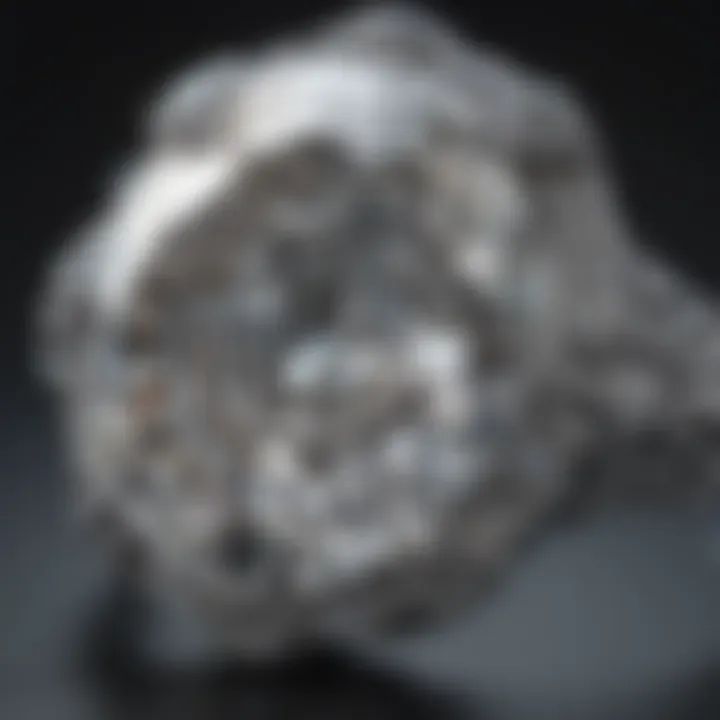
Intro
Diamond rings hold significant cultural and emotional value, often serving as symbols of love, commitment, and status. Understanding their cost entails exploring various dimensions that impact their market value. Factors such as the diamond grading system, sourcing of materials, craftsmanship in design, and current market trends play pivotal roles in determining the final price of a diamond ring.
This article will break down these elements, providing insights into each factor contributing to costs. We will also discuss alternative options within the jewelry market, equipping readers with knowledge to make informed purchasing decisions without feeling overwhelmed.
In this journey, we will first explore the foundational aspects of gemstones and their value.
Preface to Diamond Ring Pricing
Understanding the pricing of diamond rings is essential for anyone interested in purchasing or investing in fine jewelry. The cost of diamond rings can reflect not only the quality of the diamond itself but also the craftsmanship involved in its setting and any ancillary factors that might influence price. By grasping the nuances of how diamond rings are priced, customers can make informed decisions, enhancing their overall shopping experience.
The discussion of diamond ring pricing encompasses a range of components that together shape the final cost. These include market availability, diamond grading (the famous 4 Cs), and the choice of setting materials. Considering these elements helps buyers appreciate what they are paying for and why some diamonds are significantly more expensive than others.
Historical Context
Historically, diamonds were rare and often held by royalty and the wealthy elite. The perception of diamonds as symbols of love and status has evolved over centuries, especially influenced by marketing campaigns in the 20th century. Notably, the De Beers' "A Diamond is Forever" campaign dramatically shaped public perception and consumer behavior, linking diamonds with engagement and commitment. This historical backdrop is crucial for understanding the current pricing structures and cultural significance of diamonds today.
Factors such as the discovery of diamond mines in South Africa and changes in global supply chains also impacted the availability and cost of diamonds. The accessibility of diamonds has shifted perceptions and aspirations surrounding them, leading to an expanded market. Understanding this evolution provides insight into current pricing dynamics.
Current Market Overview
Today’s diamond market functions with various forces at play. The advent of e-commerce and the globalization of diamond sales have changed how diamonds are bought and sold. Consumers now have access to a wider range of choices, and competitive pricing is more common as online retailers enter the scene.
Price variations exist depending on several factors:
- Location of Purchase: Prices can differ significantly between online retailers and brick-and-mortar stores.
- Quality of the Gem: The combination of carat, cut, color, and clarity can lead to high discrepancies in pricing.
- Market Trends: Economic conditions and consumer demand continue to influence prices. For instance, during economic boom times, demand may rise significantly, pushing prices higher.
"Diamonds, due to their classic appeal and status, maintain a unique place in both the luxury market and consumer psychology."
Awareness of these factors helps potential buyers gauge the fairness of proposed prices. In this ever-evolving landscape, keeping abreast of market trends and gaining a comprehensive understanding of diamond valuation is vital for making informed purchase decisions.
The Cs: A Deep Dive
The 4 Cs of diamond grading—carat, cut, color, and clarity—are the cornerstone of understanding diamond quality and pricing. Each "C" provides essential insight into what makes a diamond unique. Grasping these concepts can drastically influence buying decisions. For instance, a small change in carat weight or cut can lead to significant price differences.
Carat Weight Explained
Carat weight evidences the size of a diamond. One carat equals 200 milligrams. While carat weight can affect the price, it is not the sole determinant of value. For example, two diamonds may have the same carat weight yet differ in price due to cut, color, and clarity. Lighter diamonds are often less expensive than those that are slightly heavier because consumers want visible size without exceeding certain monetary boundaries. Thus, pricing does not rise linearly with carat weight.
The Importance of Cut
Cut encompasses the diamond's proportions, symmetry, and polish. This factor directly influences how a diamond reflects light. Contrary to popular belief, the cut is more than just a shape; it is fundamental to a diamond's brilliance. A well-cut diamond can appear larger, while a poorly cut one can seem dull and lifeless. The cut is paramount, often overshadowing carat weight in terms of price. It conveys both aesthetic appeal and perceived value.
A well-executed cut maximizes a diamond’s light performance, making it a key element in luxury pricing.
Understanding Color and Its Impact
Color refers to the tint present in a diamond, with colorless diamonds being the most coveted. The Gemological Institute of America (GIA) grades diamond color on a scale from D (colorless) to Z (light yellow or brown). The significance of color varies by personal preference, but generally, the less color present, the higher the value. Diamonds with a hint of yellow are frequently more affordable, targeting budget-conscious buyers. Preference for particular tones can vary within cultures, but uncolored diamonds remain a global standard for desirability.
Clarity: The Hidden Costs
Clarity addresses the presence of imperfections or inclusions inside a diamond or on its surface. These imperfections are graded from Flawless (no internal or external blemishes visible under 10x magnification) to Included, where imperfections are easily seen with the naked eye. While clarity might not be as impactful on the visual appeal as cut, it plays a significant role in pricing. Diamonds graded as high clarity can command a premium, as they are rarer. Buyers, therefore, weigh clarity against their expectations when selecting a stone.
Factors Influencing Diamond Prices
Understanding the factors that influence diamond prices is crucial for anyone involved in the market. Whether you are a buyer trying to make a well-informed decision or a seller aiming to accurately price your product, knowing these influences is essential. The dynamics of pricing are not merely a reflection of the diamond's attributes; they involve economic conditions, market behaviors, and geological conditions that make certain diamonds more valuable than others.
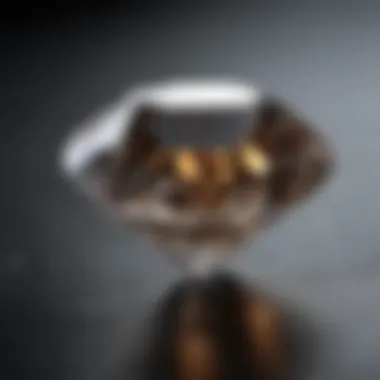
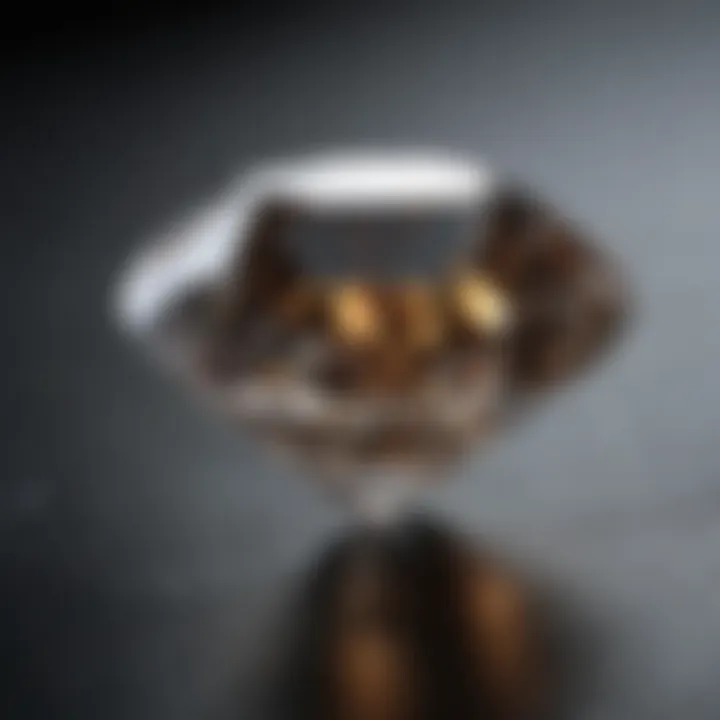
Supply and Demand Dynamics
The basic economic principle of supply and demand plays a significant role in diamond pricing. In times of high demand, prices tend to increase. This demand can be affected by various factors, including cultural trends, engagement seasons, or significant events such as holidays.
On the other hand, the supply of diamonds is not uniform. Natural diamonds take millions of years to form and are extracted from finite sources. Economic activities surrounding diamond mining can impact availability. When mines deplete or when new sources are discovered, the supply dynamics shift, affecting prices significantly.
Additionally, changes in consumer preferences can alter the demand landscape. As consumers become more educated about synthetic diamonds or alternative gemstones, the traditional diamond market could face shifts in demand.
Economic Influences
The broader economic environment also has a strong impact on diamond prices. For instance, in times of economic prosperity, there is more disposable income, often resulting in higher spending on luxury items like diamond rings. Conversely, during economic downturns, spending tends to lessen, pushing diamond prices down. Other economic indicators, such as inflation rates and interest rates, can also play their part in influencing prices.
Furthermore, global economic conditions impact diamond prices in the same way they do other commodities. Local currency fluctuations, trade policies, and market speculation can create an unpredictable environment where prices can shift rapidly.
Geological Factors Affecting Costs
Geology contributes significantly to how diamonds are priced. The rarity of certain types of diamonds directly correlates with their cost. For example, pink and blue diamonds are incredibly rare and significantly more expensive than more common white diamonds.
Moreover, the location of diamond mines can influence their extraction costs and, ultimately, their market price. Diamonds sourced from remote or unstable regions may incur higher extraction and transportation costs, thus increasing their final selling price.
Specific geological phenomena, such as the discovery of kimberlite pipes, which host diamond deposits, can also shift the market.
"The interplay of demand, economy, and geology creates a complex environment that constantly influences diamond pricing."
In summary, understanding these factors—supply and demand, economic influences, and geological characteristics—helps frame a comprehensive picture of how diamond prices are established. Individual buyers can leverage this knowledge to make informed decisions, ensuring that their investment is aligned with their values and expectations.
Metal Choices: Band Materials
When considering the cost of diamond rings, the choice of metal for the band is an important factor. Band materials not only influence the overall aesthetic of the ring but also affect its durability, maintenance, and cost. Each metal type has its unique properties and benefits, which cater to different preferences and lifestyles. Understanding these distinctions can help consumers make informed decisions that align with their personal style and value system.
Platinum vs. Gold
Platinum is often regarded as one of the most premium materials for ring bands. Its rarity and weight contribute to its higher cost. Platinum is highly durable and resistant to tarnishing, making it a great choice for those with an active lifestyle. Additionally, its natural white sheen enhances the brilliance of the diamond. However, it comes with its own considerations; platinum rings may require occasional polishing to maintain their finish due to scratches that can occur over time.
On the other hand, gold is a more traditional choice. Options include yellow gold, white gold, and rose gold, each providing a different look. Gold is generally more affordable than platinum, making it accessible for a wider range of budgets. However, the purity of gold varies, as seen in different karat options such as 14K and 18K. Higher karat gold contains more pure gold, but it can also be softer and may require more maintenance.
Ultimately, the choice between platinum and gold rests on several considerations:
- Durability: Platinum is more durable than gold.
- Appearance: Gold has various shades, while platinum maintains a consistent look.
- Cost: Gold is usually less expensive than platinum.
"Choosing the right band material is crucial as it not only enhances the ring's beauty but also affects its longevity."
Alternative Metals in Diamond Rings
With changing consumer preferences, alternative metals for diamond ring bands have become increasingly popular. Options such as tungsten, titanium, and stainless steel are now common choices.
Tungsten is known for its impressive hardness and scratch-resistance. It's ideal for those seeking a long-lasting ring that can withstand everyday wear. However, it is also heavier than other metals, which may be a consideration for some.
Titanium offers a lightweight option with excellent strength and corrosion resistance. It is a hypoallergenic metal, making it suitable for those with sensitive skin. Furthermore, titanium can be anodized to create a variety of colors, offering unique aesthetic choices.
Stainless steel is both affordable and durable. While it does not carry the same prestige as gold or platinum, it has gained popularity for its practical qualities and modern appearance. It is resistant to rust and tarnish, making it an easy-care option.
When evaluating alternative metals, consider the following:
- Weight and Comfort: Some metals may feel heavier or bulkier.
- Allergies: Hypoallergenic options like titanium are suitable for sensitive skin.
- Style: Alternatives can offer unique appearances that may not be found in traditional metals.
Sourcing and Ethical Considerations
The sourcing and ethical considerations surrounding diamond rings have become crucial in today's market. As consumers become more aware of the impact their purchases have on the environment and society, the demand for ethically sourced diamonds increases. Understanding this topic provides insight not only into the moral implications of choosing a diamond but also its potential impact on price and value.
Conflict Diamonds: What You Need to Know
Conflict diamonds, often known as blood diamonds, are gemstones mined in war zones and sold to finance armed conflict against governments. These stones have a dark reputation that significantly affects consumer preferences and perceptions of value. Buyers are becoming more selective, opting for diamonds with proven ethical origins.
In recent years, organizations have worked to combat the trade of conflict diamonds by instituting certification systems. One notable effort is the Kimberley Process, which aims to ensure that rough diamonds are not financing violence or human rights abuses. However, the effectiveness of this process has faced criticism, raising the question of whether these measures are sufficient. Many consumers now seek third-party certifications that guarantee a diamond's ethical sourcing, leading retailers to adapt to this demand.
Ethical Sourcing Practices
Ethical sourcing practices entail ensuring diamonds are sourced in ways that uphold human rights and environmental standards. This includes transparency in the supply chain, fair labor practices, and environmental responsibility. Some key ethical sourcing practices include:
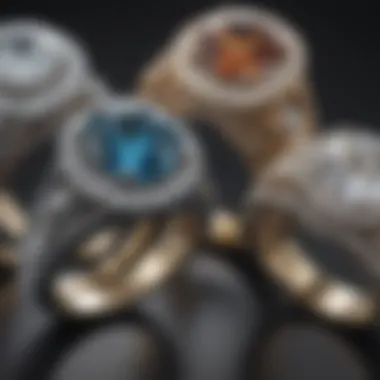
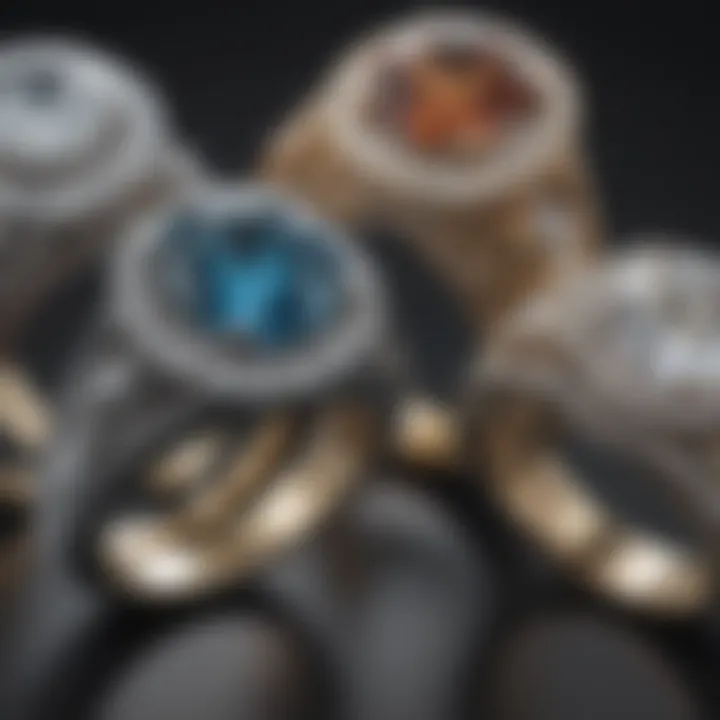
- Traceability: Ensuring that diamonds can be traced back to their origins, verifying that they are conflict-free.
- Fair Trade: Engaging with suppliers who pay fair wages and provide safe working conditions for miners.
- Environmental considerations: Implementing practices that minimize environmental degradation during the mining process.
- Support for local communities: Investing in community development projects and supporting local economies where diamonds are mined.
"Choosing ethically sourced diamonds contributes to sustainable and responsible practices in the industry."
With companies like Brilliant Earth and James Allen leading the charge in ethically sourced diamonds, consumers have more options than ever. This shift in consumer behavior not only influences the ethical landscape of diamond mining but also shapes pricing structures. Asking questions and seeking out information can lead to more informed decisions, ultimately fostering an industry that values integrity over profit.
Customization Options for Rings
Customization options for diamond rings play a crucial role in shaping both the aesthetic and the financial aspects of the purchase. Personalizing a ring allows buyers to reflect their unique tastes, create meaningful connections, and ultimately influence the cost. Each customized element provides an opportunity to adjust the final price of the ring, either elevating or balancing the overall expenditure based on individual preferences.
Consumers today seek more than just a diamond in a ring; they desire a piece that resonates with their identity or tells a story. Customization can take numerous forms, including engravings that convey a special message, unique band settings that showcase the diamond perfectly, or even incorporating additional gems. All these choices significantly affect both the emotional value and monetary cost of the ring.
When considering customization, it is essential to weigh both the artistic expression and the practicality involved. Choices should align with the wearer's lifestyle and long-term satisfaction. Thankfully, many jewelers offer consultations to help navigate preferences and ensure the final product meets expectations and budget.
Engraving and Personalization
Engraving adds a layer of sentimentality to diamond rings. This small detail can greatly enhance the ring's emotional significance. Popular phrases include names, dates, or even meaningful quotes. Custom engravings often carry a deeper meaning, making the piece one-of-a-kind.
However, there are practical considerations when choosing engravings. First, the material of the band may affect how well the engraving holds up over time. Platinum, for instance, is more durable than gold and can resist wear better. Second, the size of the ring may limit the amount of text that can fit comfortably. For those with tighter budgets, opting for simpler engravings can keep costs down.
In addition to engraving, personalization can extend to shape, size, and placement of the diamond or additional stones. Custom designs provide further avenues for expressing individuality, reflecting personal stories or styles. This depth of personalization also influences the final pricing, as labor and design complexity can drive costs in certain directions.
"A personalized ring is not just jewelry; it's a piece of art that carries personal history."
Setting Styles and Their Costs
The choice of setting style is another vital aspect of customizing a diamond ring and significantly affects its price. The setting not only supports the diamond but also influences how light interacts with it, enhancing its brilliance and overall appeal.
There are various styles available:
- Prong Setting: Classic and popular for allowing maximum light exposure. Costs depend on the number of prongs and material used.
- Bezel Setting: Surrounds the diamond completely with metal, providing more protection but often at a higher cost due to material usage.
- Halo Setting: Features smaller stones surrounding the central diamond. This option can make the center diamond appear larger, usually increasing costs due to additional stones and labor.
- Pave Setting: Rows of small stones are set closely together, which adds sparkle. This intricate work can increase labor costs significantly.
When discussing costs, the setting style plays a role in determining not just the price of materials but also the amount of labor involved. Customized settings require skilled craftsmanship, which adds to the overall pricing structure. Careful selection of the setting style can help balance budget and design desires effectively.
Alternative Stones: Cost Comparisons
Understanding alternative stones is essential when discussing the cost of diamond rings. Many buyers may not realize that there are several admirable substitutes available. These options can often provide similar visual appeal without the premium price tag associated with natural diamonds. Exploring these alternatives can lead to more informed decisions about jewelry purchases, aligning personal tastes and budgets.
Moissanite as an Option
Moissanite is one of the most popular alternatives to diamonds. It bears a striking resemblance to diamonds due to its brilliance and fire. The key features of moissanite includ:
- Cost-Effective: On average, moissanite is significantly less expensive than diamonds. Prices typically range from 10-20% of what one would pay for a comparable diamond, making it a budget-friendly choice.
- Durability: With a hardness rating of 9.25 on the Mohs scale, moissanite is one of the hardest gemstones, second only to diamonds. This means it can withstand everyday wear without scratching or breaking.
- Ethical Option: Moissanite is lab-created, ensuring that it is conflict-free, appealing to the ethical consumer. This aspect is increasingly relevant in today's market.
However, some may note differences between moissanite and diamonds. Moissanite tends to exhibit a more colorful sparkle and a slightly different visual appearance, which could appeal to certain buyers while putting off others.
Lab-Created Diamonds: Pros and Cons
Lab-created diamonds offer another alternative for buyers who desire a diamond-like appearance without the high cost of natural stones. Here are the pros and cons of lab-created diamonds:
Pros:
- Affordability: Lab-created diamonds can be 20-40% cheaper than their mined counterparts. This lower price point allows buyers to purchase larger stones or higher quality gemstones.
- Ethical and Sustainable: Like moissanite, lab-created diamonds are free from the ethical concerns tied to mining, such as conflict trade. This has become an increasingly important factor for many consumers.
- Identical Characteristics: Lab diamonds possess the same physical and chemical properties as mined diamonds. To the untrained eye, they look identical, making them a suitable substitute for many.
Cons:
- Resale Value: Lab-created diamonds do not retain their value like natural diamonds. Their market value tends to decrease after purchase, which may deter some buyers.
- Perception: Despite quality, some individuals may still prefer natural diamonds for their historical and emotional significance. The authenticity factor remains a consideration in personal preference.
Understanding these options advanced knowledge about the market. By reviewing the various alternatives, consumers are better prepared to make decisions that reflect their values, budget, and aesthetic preferences.
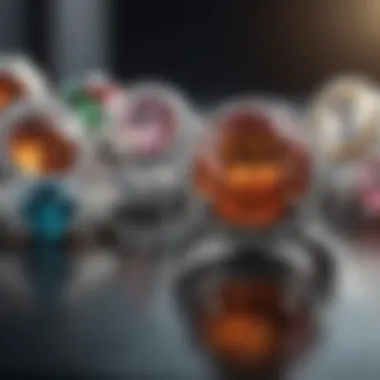
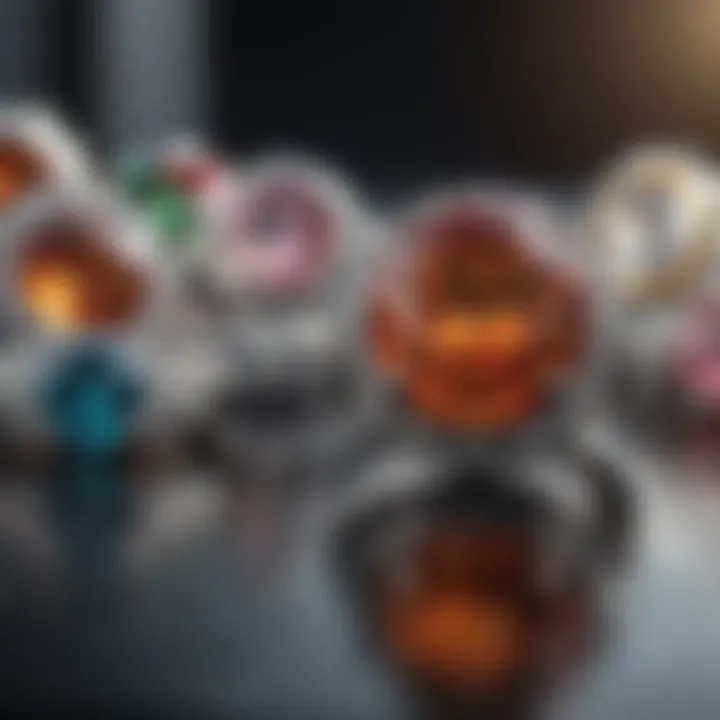
The Role of Retailers in Pricing
The role of retailers significantly shapes the cost of diamond rings. Their strategies and choices can either inflate or deflate prices, greatly impacting the buyer's experience. Retailers serve as intermediaries between diamond suppliers and consumers, which adds complexity to the pricing mechanism. Understanding this relationship is vital for consumers who wish to make informed purchases.
Retailers have a variety of ways to influence prices, including product selection, brand positioning, and customer service. High-profile jewelers, for instance, may charge a premium for their exclusive collections. On the other hand, smaller or online retailers might offer competitive pricing due to lower overhead costs. This difference highlights the importance of evaluating various retailers before making a final decision.
Moreover, customer service and shopping experience play crucial roles in pricing. Retailers that offer exceptional customer support or personalized services might justify higher costs. It is essential to discern whether the added value from a retailer’s service matches the price increase.
Understanding Retail Markup
Retail markup refers to the added cost a retailer applies to the wholesale price to establish a selling price. Typically, this markup can range from 20% to 100%, depending on several factors such as brand perception, store location, and target market.
- Brand Name: Renowned brands often command higher markups due to their established reputation. Consumers are sometimes willing to pay more for the assurance of quality and prestige.
- Location: Retailers in upscale neighborhoods may charge more based on their clientele's purchasing power.
- Market Trends: Following fashion trends can also affect the markup. If a particular style is in demand, costs may rise accordingly.
Knowing how markup works can help buyers negotiate better prices or consider alternatives that offer similar quality at lower prices. Understanding this dynamic is vital for making economical decisions in the diamond ring market.
Negotiation: Is It Possible?
Negotiation in the context of diamond ring pricing is not only possible, but it can also be advantageous. Many retailers expect customers to engage in some form of negotiation, especially in high-value purchases like diamond rings.
Factors to consider when negotiating include:
- Market Research: Being informed about market prices equips consumers with the knowledge needed to argue for better deals.
- Timing: Purchases made during off-peak times or holiday seasons might lead to better negotiation outcomes. Retailers often have clear goals for sales volume and may be more flexible.
- Payment Methods: Some retailers may offer discounts for cash payments versus credit cards, making negotiation strategies need to be adaptable.
While negotiating, it is also helpful to build rapport with the salesperson. A friendly exchange might lead to discounts or perks not advertised publicly. Keep in mind that not all retailers have the same flexibility, but engaging them in conversation can sometimes lead to substantial savings.
"Understanding the retail landscape enables consumers to approach their purchases with a strategy, rather than passively accepting the price on the tag."
Future Trends in Diamond Ring Pricing
Future trends in diamond ring pricing are crucial for both consumers and industry professionals. Understanding these trends can help buyers make informed decisions while maximizing their investment. Several factors play into the expected changes in pricing, including market dynamics, consumer preferences, and advancements in technology.
Market Predictions
Market predictions suggest several key trends that may shape the future of diamond pricing. Firstly, the demand for diamonds continues to evolve. As sustainability becomes a priority for many consumers, ethically sourced diamonds might gain popularity. This change can potentially lead to a rise in prices for conflict-free diamonds as buyers seek to align their purchases with their values.
Analysts also foresee an increasing demand for personalized and unique pieces, which may affect pricing structures. Customization often comes at a premium, and this trend can result in higher prices for unique diamond rings tailored to individual preferences.
Furthermore, global economic factors can influence the market. For example, fluctuations in the economy can impact consumer spending. A stronger economy often correlates with a willingness to invest in luxury items such as diamond rings.
Technological Advances in Diamond Sourcing
Technological advances present both opportunities and challenges for the diamond market. One significant development is the rise of lab-grown diamonds, which replicate natural diamonds but at a lower cost. This innovation challenges traditional diamond pricing, as lab-grown diamonds can provide a more affordable alternative. Consumers may increasingly choose lab-grown diamonds for ethical reasons or budget constraints.
Moreover, advancements in mining technology can lead to more efficient extraction processes. Improvements in extraction can lower costs and potentially stabilize supply chains. However, this could also result in fluctuating prices depending on external market conditions.
In summary, the future of diamond ring pricing will likely be influenced by a combination of market supply and demand, consumer preferences, and advancements in technology. As these factors evolve, they will shape how diamonds are valued and priced.
Closure: Informed Decision-Making
Aligning Personal Values with Spending
Consumers must consider personal values carefully when investing in a diamond ring. The need for authenticity and ethical considerations drives many buyers today. They may prioritize conflict-free sourcing or eco-friendly practices while choosing a retailer. Additionally, preferences for unique designs or craftsmanship can also influence spending.
Elements worthy of consideration include:
- Sourcing Practices: Where the diamond comes from can greatly affect value and personal satisfaction.
- Craftsmanship: A well-crafted ring may appeal to the buyer's desire for quality over quantity.
- Personal Significance: Rings often carry emotional weight, and this can justify higher spending if the item resonates on a personal level.
Understanding these components allows buyers to choose a ring that reflects both their values and their budget.
Final Thoughts on Costs and Worth
Ultimately, cost and worth are interrelated yet distinct concepts. Cost refers to the monetary value of the ring, while worth encompasses emotional, ethical, and aesthetic considerations.
When making a purchase, it can be valuable to ask:
- What value does this diamond ring hold for me personally?
- Am I comfortable with the ethical implications of this purchase?
- Does this ring reflect my style or life story, justifying its cost?
By evaluating these aspects, buyers can decide if a diamond ring represents a fair exchange of money for worth. As consumers navigate the world of diamond rings, informed decision-making is crucial. This not only leads to satisfaction post-purchase but also ensures the acquisition contributes positively to one’s values, story, and experience.







